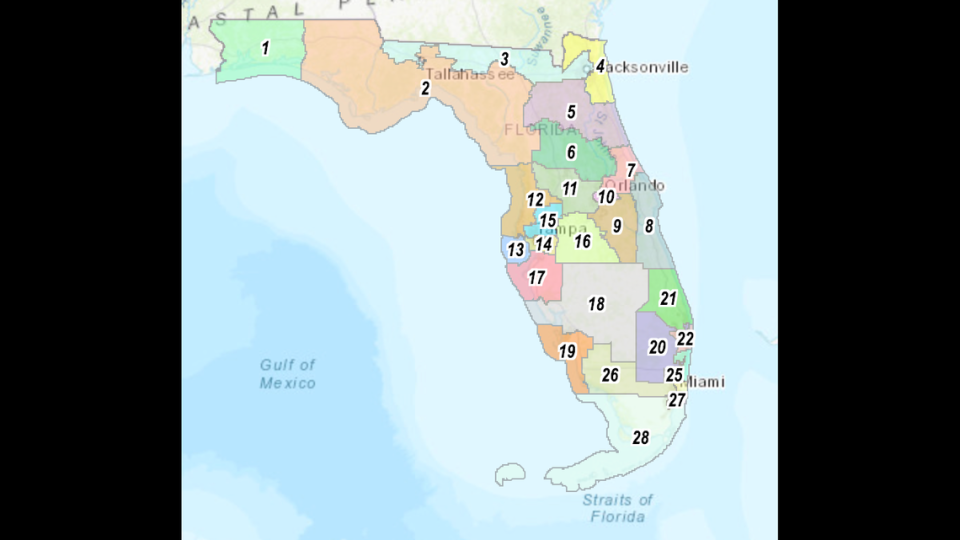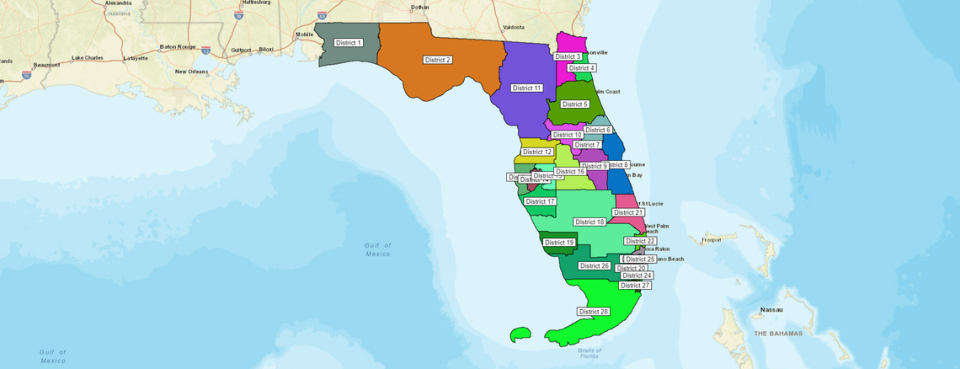DeSantis makes veto threat of Republican congressional redistricting map
- Oops!Something went wrong.Please try again later.
Setting up a potential constitutional conflict with members of his own party, Gov. Ron DeSantis threatened Friday to veto a congressional redistricting map if legislators send him the plan that has already passed the state Senate and is similar to one proposed by the state House.
“We will not be signing any congressional map that has an unconstitutional gerrymander in it, and that is going to be the position that we stick to. So just take that to the bank,’’ the governor said at a news conference in the North Florida city of Marianna.
At issue is the configuration of the congressional district held by U.S. Rep. Al Lawson, a Black Democrat. The district stretches 140 miles from Tallahassee to Jacksonville and links traditionally Black communities that were once home to the state’s wealthy cotton plantations. That district is known as Florida Congressional District 5 currently but is District 3 on the map being considered by the House.
The governor has veto power over the congressional redistricting map, and each chamber must have a two-thirds vote to override his veto.
Neither Senate President Wilton Simpson nor House Speaker Chris Sprowls said they would comment on the governor’s remarks Friday. But the issue has the potential to ignite a legal battle between the Republican governor and the Republican-controlled Legislature over how far to go to protect minority districts.
North Florida district at issue
The district DeSantis has called a “gerrymander” is the same one House and Senate leaders have said is designed to follow Florida law, primarily the Fair Districts standards of the state Constitution. Those standards prohibit the state from enacting a congressional map that diminishes Black voting strength and are modeled after the federal Voting Rights Act.

DeSantis’ lawyer, Ryan Newman, has called Lawson’s congressional district “an illegal gerrymander” and, citing a 2017 ruling from the U.S. Supreme Court, said it should be drawn in a more “cohesive geographic area.”
Many legal experts have said the ruling is just one of several that signal the increasingly conservative high court is open to rolling back long-established protections for communities of color in redistricting.
“Gov. DeSantis may try to push a racial gerrymandering theory but it’s not clear that he will win,’’ said Michael Li, a redistricting expert at the Brennan Center for Justice. Because of the Fair District standards in the state Constitution, he said, “Florida now has more robust protections than are available under federal law.”
In January, DeSantis set out to challenge that assumption and submitted his own congressional redistricting plan, something no governor had publicly done before.
The proposed map not only dismantled the current District 5 held by Lawson, it altered Congressional District 10, which is held by Democrat Val Demings, also a Black Democrat, and slashed the number of congressional districts that give Black candidates the opportunity to be elected from four to two.
The state Senate refused to consider the map and unanimously adopted a congressional map that leaves District 5 intact. The governor then asked the Florida Supreme Court to advise him on the legal questions surrounding the district, and the state House responded by putting a pause on its congressional map.

On Thursday, the court refused the governor’s request, saying it did not have enough facts to make a fair ruling.
Sprowls told reporters that the governor’s question raised a “novel legal argument,” and the House was unlikely to adopt his approach.
“We’re probably not in a position to be able to address novel legal arguments in our process, which is why had we gotten guidance from the Supreme Court that may have enlightened that,’’ he said. “But, in the absence of that guidance, in the absence of legal precedent ... we are going to follow the law.”
House map differs from DeSantis’ option
Within the hour of Sprowls’ remarks, the House released a congressional map that would give Republicans 18 seats, two more than the current congressional delegation, and give Democrats 10 seats, one less than they have now.
Although the House preserves the configuration of District 5, as the Senate’s congressional map does, it advantages Republicans in other parts of the state. In Orlando, for example, it splits Orange County’s Black voters into three districts, diluting their voting strength.
By contrast, the map passed by the state Senate has 16 districts that would have been won by former President Donald Trump and 12 that would have been won by President Joe Biden, giving Democrats the additional congressional seat Florida gets because of the state’s population growth.
DeSantis’ proposed map, however, not only eliminates District 5, it creates 18 seats that were won by Trump and 10 that voted for Biden. In two of the Biden districts, the Democrat won by less than one percentage point making them easy toss-up districts in a competitive election year.
The current map was approved by the Florida Supreme Court in 2015, after the court struck down the Legislature’s previous map as a violation of the Fair District standards of the state Constitution because it was drawn to favor Republicans and incumbent politicians.
It is unclear why DeSantis has decided to continue to fight against members of his own party.
DeSantis is seen as a national contender for the GOP presidential nomination in 2024. Trump’s former senior adviser, Stephen K. Bannon, has taken credit for provoking DeSantis into drafting a more partisan map.
Bannon, who hosts the “War Room” podcast, a popular daily show among Trump devotees, said on his show in January that after he asked his supporters to pressure DeSantis into submitting a map more favorable to Republicans, the governor listened.
“The map came out, and this is 100% [due to] the ‘War Room’ and particularly all the great citizens down in Florida,’’ Bannon said, the Washington Post reported on Friday.
The governor also used the news conference to send other signals to Simpson and Sprowls.
After the presiding officers told reporters this week they were not inclined to adopt the governor’s plan to cut gas taxes by $1 billion because it would benefit out-of-state tourists as much as Floridians, the governor said he is still expecting it and DeSantis insisted that issue was not dead.
“We’re working hard on some gas tax relief for Floridians,” he said.
The governor also criticized a House-backed proposal to take away $200 million from a dozen districts that have implemented strict mask mandates against the wishes of the DeSantis administration and suggested the Legislature should allow parents to sue school officials instead.
He also said he wants legislators to punish private schools that continue to operate with a mask mandate by withholding any state scholarship funds they receive as punishment.
Mary Ellen Klas can be reached at meklas@miamiherald.com and @MaryEllenKlas

